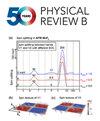氮化镓p-i-n二极管的阱辅助奥格-迈特纳复合
IF 3.7
2区 物理与天体物理
Q1 Physics and Astronomy
引用次数: 0
摘要
半导体器件的大部分性能是由浅层杂质决定的。然而,深层缺陷通常在复合过程或强场输运中起着重要作用。虽然有各种各样的技术可用于评估杂质的密度和能级,但其他性质,如缺陷的重组机制,无法观察到。我们报道了氮化镓二极管中陷阱辅助奥格-迈特纳复合(TAAR)产生的热电子的直接测量。通过对表面被铯激活为负电子亲和的二极管进行电子发射光谱(EES)分析,我们观察到在低电流注入下二极管的溢出电子。然而,当在更高的电流密度下操作器件时,低至~ 25 A/cm2,我们测量了高能电子的发射。与使用EES在发光二极管(led)中观察到的热电子不同,在我们测试的电流下,二极管中产生的热电子不可能来自奥格-迈特纳重组,因为二极管的载流子密度比led中的载流子密度低得多。在我们的测量过程中,我们观察到在各种偏压条件下,能量为~ 0.42 eV, ~ 0.99 eV, ~ 1.43 eV和~ 2.32 eV的累积电子发射高于传导带最小值(CBM),这表明在这些能量下GaN中存在传导带特征,其中电子可以长寿命,例如卫星谷最小值和拐点。由于二极管偏向于高电流,我们还测量了在CBM以上接近能量1.97±0.13 eV和2.94±0.13 eV的不完全松弛热电子,这表明至少一些TAAR参与缺陷的能级在远离导带或价带边缘的地方分别为> 1.97 eV和> 2.94 eV。此外,在我们的最高工作电流下,我们测量了能量为3.28±0.13 eV的热电子,这为涉及浅层杂质的TAAR过程提供了直接证据。氮化镓二极管中TAAR的意外发现凸显了进一步研究氮化镓缺陷的重要性,以及将缺陷辅助重组循环的多声子发射、辐射和TAAR捕获步骤纳入器件建模的必要性。此外,本实验证明了最简单的半导体结构二极管作为研究半导体材料丰富复合物理的试验台的适用性。2025年由美国物理学会出版本文章由计算机程序翻译,如有差异,请以英文原文为准。
Trap-assisted Auger-Meitner recombination in GaN p-i-n diodes
Most properties of semiconductor devices are dominated by shallow impurities. However, deep defects often play an important role, for instance, in recombination processes or high field transport. While a variety of techniques are available to assess the density and energy levels of impurities, other properties, such as the recombination mechanisms of the defects, escape observation. We report on the direct measurement of hot electrons generated by trap-assisted Auger-Meitner recombination (TAAR) in GaN diodes. By performing electron emission spectroscopy (EES) on diodes with surfaces activated to negative electron affinity by cesium, we observe the expected overflow electrons of diodes under low current injection. However, when operating the devices at higher current densities, as low as ∼25 A/cm2, we measure the emission of high-energy electrons. At variance with the observed hot electrons in light-emitting diodes (LEDs) using EES, the hot electrons generated in diodes at our tested currents cannot be from Auger-Meitner recombination due to the diodes' significantly lower carrier densities compared to those in LEDs. During our measurements, we observe the emission of accumulated electrons with energies ∼0.42 eV, ∼0.99 eV, ∼1.43 eV, and ∼2.32 eV above the conduction-band minimum (CBM) at various bias conditions, suggesting the existence of conduction-band features in GaN at these energies where electrons can be long-lived, such as satellite-valley minima and inflection points. We also measure incompletely relaxed hot electrons approaching energies 1.97 ± 0.13 eV and 2.94 ± 0.13 eV above the CBM, as the diodes are biased to high currents, suggesting at least some of the TAAR partaking defects have an energy level ≳ 1.97 ≳ 2.94 Published by the American Physical Society 2025
求助全文
通过发布文献求助,成功后即可免费获取论文全文。
去求助
来源期刊

Physical Review B
物理-物理:凝聚态物理
CiteScore
6.70
自引率
32.40%
发文量
0
审稿时长
3.0 months
期刊介绍:
Physical Review B (PRB) is the world’s largest dedicated physics journal, publishing approximately 100 new, high-quality papers each week. The most highly cited journal in condensed matter physics, PRB provides outstanding depth and breadth of coverage, combined with unrivaled context and background for ongoing research by scientists worldwide.
PRB covers the full range of condensed matter, materials physics, and related subfields, including:
-Structure and phase transitions
-Ferroelectrics and multiferroics
-Disordered systems and alloys
-Magnetism
-Superconductivity
-Electronic structure, photonics, and metamaterials
-Semiconductors and mesoscopic systems
-Surfaces, nanoscience, and two-dimensional materials
-Topological states of matter
 求助内容:
求助内容: 应助结果提醒方式:
应助结果提醒方式:


